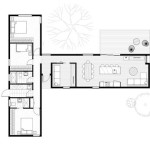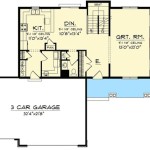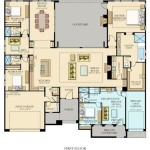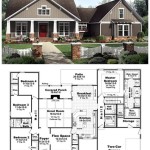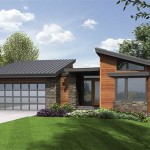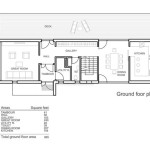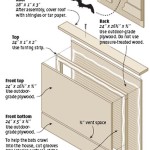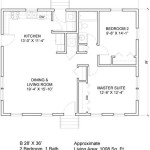A floor plan, also known as a floor plan diagram, floor plan drawing or house plan, is a type of technical drawing that shows all levels of a building or house. A floor plan typically contains the layout of rooms with long-term fixtures and equipment. It can be used for a variety of purposes, such as planning the construction of a new building, renovating an existing one, or simply understanding the layout of a space.
Contemporary houses are a popular choice for those looking for a modern and stylish home. These homes are typically characterized by their clean lines, open floor plans, and use of natural materials. Floor plans for contemporary houses can vary widely, but they all share some common features, such as a focus on maximizing natural light, creating a sense of space, and integrating indoor and outdoor living areas. These homes are designed to be comfortable, efficient, and stylish, making them a great choice for those who want a modern and inviting home.
Modern floor plans for contemporary houses prioritize functionality, space planning, and natural light incorporation. Let’s dive deeper into the main elements that make these floor plans a perfect choice for contemporary homes.
Floor plans for contemporary houses offer a unique blend of style and functionality. Here are 8 key points to consider when designing a floor plan for a contemporary house:
- Open floor plan
- Natural light
- Indoor-outdoor flow
- Sustainable design
- Smart home technology
- Universal design
- Energy efficiency
- Customization
By incorporating these elements into your floor plan, you can create a contemporary house that is both stylish and functional.
Open floor plan
An open floor plan is a popular feature of contemporary houses. This type of floor plan creates a more spacious and inviting feel by eliminating walls and partitions between different rooms. This can be especially beneficial in smaller homes, as it can make the space feel larger and more open.
- Improved flow of natural light: Open floor plans allow for more natural light to penetrate the home, creating a brighter and more inviting space.
- Increased sense of space: By eliminating walls and partitions, open floor plans create a more spacious and airy feel, making the home feel larger than it actually is.
- Enhanced communication and interaction: Open floor plans facilitate communication and interaction between family members and guests, as they can easily see and hear each other from different parts of the home.
- Greater flexibility and adaptability: Open floor plans offer greater flexibility and adaptability, as furniture and other elements can be easily rearranged to suit changing needs and preferences.
Open floor plans are a great way to create a more modern and inviting home. They can be especially beneficial for families with young children, as they allow for easier supervision and interaction.
Natural light
Natural light is an essential element of any contemporary house. It can make a space feel more inviting, spacious, and healthy. There are a number of ways to incorporate natural light into your floor plan, including:
- Windows: Windows are the most common way to bring natural light into a home. When placing windows, consider the size, shape, and orientation of the window in relation to the room. You want to maximize the amount of natural light that enters the room, while also ensuring that the windows are not too large or too small for the space.
- Skylights: Skylights are another great way to bring natural light into a home. They can be placed in any room of the house, and they can provide a dramatic source of light. Skylights are especially effective in rooms with high ceilings, as they can help to brighten the entire space.
- French doors: French doors are a great way to connect the indoors and outdoors. They can be used to create a seamless transition between the two spaces, and they can also provide a source of natural light. French doors are a popular choice for living rooms, dining rooms, and kitchens.
- Atriums: Atriums are a type of open space that is surrounded by walls or windows. They can be used to bring natural light into the center of a home, and they can also create a sense of spaciousness. Atriums are a popular choice for large homes, as they can help to create a more open and inviting feel.
By incorporating natural light into your floor plan, you can create a more healthy, inviting, and stylish home.
Indoor-outdoor flow
Indoor-outdoor flow is a key element of contemporary house design. This refers to the seamless transition between the interior and exterior spaces of a home. By creating a strong connection between these two spaces, you can create a more inviting and comfortable home that feels more connected to nature.
There are a number of ways to create indoor-outdoor flow in your floor plan. One way is to use large windows and doors that open up to the outdoors. This can create a more open and airy feel, and it can also make it easier to enjoy the views from your home. Another way to create indoor-outdoor flow is to use outdoor living spaces, such as patios, decks, and balconies. These spaces can be used for entertaining, relaxing, or simply enjoying the outdoors. By creating a strong connection between the indoors and outdoors, you can create a more inviting and comfortable home that feels more connected to nature.
Here are some additional tips for creating indoor-outdoor flow in your floor plan:
- Use large windows and doors that open up to the outdoors.
- Create outdoor living spaces, such as patios, decks, and balconies.
- Use natural materials, such as wood and stone, to create a seamless transition between the indoors and outdoors.
- Plant trees and shrubs around your home to create a more natural setting.
- Use water features, such as fountains and pools, to create a more relaxing and inviting outdoor space.
By following these tips, you can create a floor plan that takes advantage of the natural surroundings and creates a more inviting and comfortable home.
Sustainable design
Sustainable design is an important consideration for any contemporary house. It refers to the practice of designing and building homes in a way that minimizes their environmental impact. There are a number of ways to incorporate sustainable design into your floor plan, including:
Energy efficiency: Energy-efficient homes use less energy to heat, cool, and power, which can save you money on your utility bills and reduce your carbon footprint. There are a number of ways to make your home more energy-efficient, such as using energy-efficient appliances, installing solar panels, and improving insulation.
Water conservation: Water conservation is another important aspect of sustainable design. There are a number of ways to conserve water in your home, such as installing low-flow fixtures, collecting rainwater, and using drought-tolerant landscaping.
Material selection: The materials you choose for your home can also have a significant impact on its environmental impact. Sustainable materials are those that are produced in a way that minimizes environmental harm. Some examples of sustainable materials include recycled materials, renewable resources, and low-VOC (volatile organic compound) materials.
Indoor air quality: Indoor air quality is also an important consideration for sustainable design. Poor indoor air quality can lead to a number of health problems, such as asthma, allergies, and respiratory infections. There are a number of ways to improve indoor air quality, such as using natural ventilation, avoiding the use of harmful chemicals, and installing air purifiers.
By incorporating sustainable design into your floor plan, you can create a home that is more environmentally friendly, healthier, and more comfortable.
Smart home technology
Smart home technology is another important consideration for contemporary house design. It refers to the use of technology to automate and control various aspects of the home, such as lighting, heating, cooling, and security. Smart home technology can make your life easier, more comfortable, and more secure.
There are a number of different smart home technologies available, including:
- Smart lighting: Smart lighting allows you to control the lights in your home from your smartphone or tablet. You can turn lights on and off, dim them, and change their color. Smart lighting can also be used to create scenes, such as a “movie night” scene or a “relaxation” scene.
- Smart thermostats: Smart thermostats allow you to control the temperature in your home from your smartphone or tablet. You can set different temperatures for different times of day, and you can also create schedules for your thermostat. Smart thermostats can help you save money on your energy bills and make your home more comfortable.
- Smart security systems: Smart security systems allow you to monitor your home from anywhere in the world. You can receive alerts if there is a break-in or if there is a fire. Smart security systems can also be used to control your locks, lights, and other devices.
- Smart home hubs: Smart home hubs allow you to connect all of your smart home devices to a single app. This makes it easy to control all of your devices from one place. Smart home hubs can also be used to create scenes and schedules for your smart home devices.
By incorporating smart home technology into your floor plan, you can create a home that is more convenient, comfortable, and secure.
Here are some additional benefits of smart home technology:
- Convenience: Smart home technology can make your life easier by automating tasks such as turning on the lights, adjusting the thermostat, and locking the doors. You can control your smart home devices from anywhere in the world using your smartphone or tablet.
- Comfort: Smart home technology can make your home more comfortable by creating the perfect environment for your needs. You can use smart lighting to create the perfect ambiance for any occasion, and you can use smart thermostats to keep your home at the perfect temperature.
- Security: Smart home technology can help to keep your home safe and secure. You can use smart security systems to monitor your home for break-ins and fires, and you can use smart locks to control who has access to your home.
If you are considering building or renovating a contemporary house, be sure to incorporate smart home technology into your floor plan. It is a great way to make your home more convenient, comfortable, and secure.
Universal design
Universal design is the practice of designing products and environments that can be used by people of all abilities and disabilities. This includes people of different ages, sizes, and abilities. Universal design is important for creating homes that are accessible and comfortable for everyone.
There are a number of ways to incorporate universal design into your floor plan. One way is to use wider doorways and hallways. This makes it easier for people with mobility impairments to move around the home. Another way to incorporate universal design is to use ramps instead of stairs. This makes it easier for people with wheelchairs or other mobility impairments to access different levels of the home. Additionally, you can install grab bars in the bathroom and kitchen to make it easier for people with balance issues to get around.
Universal design also includes the use of assistive technology. Assistive technology can help people with disabilities to live more independently. Some examples of assistive technology include wheelchairs, hearing aids, and speech recognition software. By incorporating universal design into your floor plan, you can create a home that is accessible and comfortable for everyone.
Here are some additional benefits of universal design:
- Increased accessibility: Universal design makes homes more accessible for people of all abilities and disabilities. This includes people of different ages, sizes, and abilities.
- Improved quality of life: Universal design can improve the quality of life for people with disabilities by making it easier for them to live independently.
- Increased property value: Homes that are designed with universal design features are often more valuable than homes that are not.
If you are considering building or renovating a contemporary house, be sure to incorporate universal design into your floor plan. It is a great way to create a home that is accessible and comfortable for everyone.
Energy efficiency
Energy efficiency is an important consideration for any contemporary house. It refers to the practice of designing and building homes that use less energy to heat, cool, and power. There are a number of ways to incorporate energy efficiency into your floor plan, including:
Insulation: Insulation is one of the most important factors in determining the energy efficiency of a home. It helps to keep the heat in during the winter and the heat out during the summer. There are a number of different types of insulation available, so be sure to choose one that is appropriate for your climate and budget.
Windows and doors: Windows and doors are another important factor in determining the energy efficiency of a home. Energy-efficient windows and doors are designed to minimize heat loss and gain. Look for windows and doors that have a high Energy Star rating.
Appliances: The appliances you choose for your home can also have a significant impact on its energy efficiency. Energy-efficient appliances use less energy to operate, which can save you money on your utility bills. Look for appliances that have a high Energy Star rating.
Lighting: Lighting is another area where you can save energy in your home. Energy-efficient lighting uses less energy to produce the same amount of light. Look for light bulbs that have a high Energy Star rating.
Renewable energy: Renewable energy sources, such as solar and wind power, can also be used to make your home more energy efficient. Solar panels can be used to generate electricity, and wind turbines can be used to generate power. By incorporating renewable energy sources into your floor plan, you can reduce your reliance on fossil fuels and save money on your utility bills.
By incorporating energy efficiency into your floor plan, you can create a home that is more comfortable, affordable, and sustainable.
Here are some additional benefits of energy efficiency:
- Reduced energy costs: Energy-efficient homes use less energy to heat, cool, and power, which can save you money on your utility bills.
- Increased comfort: Energy-efficient homes are more comfortable to live in because they are better insulated and have more efficient heating and cooling systems.
- Reduced environmental impact: Energy-efficient homes have a reduced environmental impact because they use less energy and produce fewer greenhouse gases.
If you are considering building or renovating a contemporary house, be sure to incorporate energy efficiency into your floor plan. It is a great way to save money, increase comfort, and reduce your environmental impact.
Customization
Customization is another important consideration for contemporary house floor plans. It refers to the ability to tailor the floor plan to your specific needs and preferences. This can include changing the layout of the rooms, adding or removing features, and choosing the finishes and materials that you want.
There are a number of ways to customize your floor plan. One way is to work with an architect to create a custom design. This gives you the most flexibility to create a home that is perfectly suited to your needs. Another way to customize your floor plan is to choose a pre-designed plan and make modifications to it. This can be a more affordable option than working with an architect, and it still allows you to make some changes to the plan to make it more your own.
When customizing your floor plan, there are a number of things to consider. One important consideration is the size and layout of the rooms. You want to make sure that the rooms are large enough to accommodate your needs, and that they are laid out in a way that makes sense for your lifestyle. Another important consideration is the flow of the home. You want to make sure that the rooms flow well together and that there are no awkward transitions.
Finally, you need to consider the finishes and materials that you want to use. The finishes and materials you choose will have a significant impact on the look and feel of your home. You want to choose finishes and materials that are durable and easy to maintain, and that reflect your personal style.
By customizing your floor plan, you can create a home that is perfectly suited to your needs and preferences. It is a great way to make your home more comfortable, stylish, and unique.
Here are some additional benefits of customization:
- Increased flexibility: Customization gives you the flexibility to create a home that is perfectly suited to your needs and preferences.
- Improved comfort: A customized home is more comfortable to live in because it is designed to meet your specific needs.
- Increased style: Customization allows you to create a home that reflects your personal style.
- Increased value: A customized home is often more valuable than a home that is not customized.
If you are considering building or renovating a contemporary house, be sure to consider customization. It is a great way to create a home that is unique, stylish, and comfortable.

.jpg)








Related Posts

